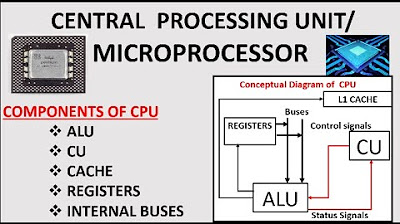CPU - Organisasi dan Arsitektur Komputer
Summary
TLDRThis lecture explains the function and components of the CPU (Central Processing Unit), often referred to as the brain of the computer. It covers the CPU's essential tasks, such as executing instructions, performing arithmetic and logical operations, and controlling other devices. The video delves into the CPU's key components, including the Arithmetic Logic Unit (ALU), Control Unit (CU), registers, cache memory, and buses, explaining how each part contributes to the computer's overall performance. Additionally, the lecture provides analogies to make the complex workings of the CPU more relatable and understandable for the audience.
Takeaways
- 😀 The CPU, also known as the brain of the computer, is responsible for executing instructions and managing operations like arithmetic, logical, and I/O tasks.
- 😀 The CPU performs four main tasks: taking and encoding program instructions, executing program instructions, performing arithmetic/logical operations, and controlling communication between components.
- 😀 The Arithmetic Logic Unit (ALU) performs basic arithmetic (addition, subtraction) and logical operations (AND, OR, XOR).
- 😀 The Control Unit (CU) is responsible for controlling the flow of instructions and data within the CPU, ensuring the correct sequence of operations.
- 😀 Registers are small, fast storage areas in the CPU that temporarily hold data and instructions to speed up processing.
- 😀 Cache memory stores frequently used data near the CPU to reduce the time spent accessing slower RAM, improving performance.
- 😀 The CPU communicates with other components via the bus, which transports control, data, and address information.
- 😀 There are different levels of cache memory (L1, L2, L3) with varying sizes and speeds. L1 is the fastest, and L3 is the largest.
- 😀 The bus system in a computer consists of three main types: the data bus (transfers data), the address bus (specifies data locations), and the control bus (manages read/write operations).
- 😀 The CPU coordinates the entire computer system, managing tasks like fetching instructions from memory, processing them, and storing results in registers or memory.
Q & A
What is the role of the CPU in a computer?
-The CPU, or Central Processing Unit, is often referred to as the brain of the computer. It is responsible for executing instructions, managing operations such as arithmetic and logical calculations, and controlling communication between different components in the computer system.
What are the key tasks performed by the CPU?
-The CPU performs four key tasks: fetching, decoding, and executing instructions; performing arithmetic and logical operations; controlling communication with other devices; and managing input/output operations.
What is the function of the Arithmetic Logic Unit (ALU)?
-The ALU performs arithmetic operations (such as addition, subtraction, multiplication, and division) and logical operations (such as conjunction, disjunction, negation, and XOR). It is the part of the CPU responsible for executing these operations on data.
How does the Control Unit (CU) work within the CPU?
-The Control Unit (CU) coordinates the CPU's activities by controlling the flow of instructions and managing how components like the ALU, registers, and memory work together. It fetches instructions, decodes them, and directs other components to execute the necessary tasks.
What role do registers play in CPU operations?
-Registers are small, fast storage locations in the CPU used to temporarily store data and instructions while the CPU processes them. They speed up operations by allowing quick access to frequently used data during calculations.
What is cache memory, and how does it enhance CPU performance?
-Cache memory is a small, high-speed memory located near the CPU that stores frequently used data or instructions. It helps improve performance by reducing the time it takes for the CPU to access data from slower main memory (RAM).
What is the difference between Level 1, Level 2, and Level 3 cache memory?
-Level 1 (L1) cache is the fastest and smallest, located directly inside the CPU. Level 2 (L2) cache is slightly larger and located near the CPU, offering moderate speed. Level 3 (L3) cache is even larger, located between CPU cores, and works slower than L1 and L2 caches but faster than RAM.
How does the bus work in the context of a CPU?
-A bus is a communication channel used to transfer data and control signals between components. The CPU uses the address bus to send data locations to RAM, while the data bus transfers actual data. The control bus manages signals like read, write, and other commands.
What are the three types of buses in a computer system?
-The three types of buses are: the data bus (which transfers data), the address bus (which identifies the memory address of data), and the control bus (which sends control signals to manage the flow of operations).
What is the analogy used to explain how CPU components work together?
-The CPU's components are likened to a human brain, with the ALU acting as the brain that performs operations, the CU as a traffic controller managing the flow of instructions, registers as a small notebook storing temporary data, and cache memory as a work desk providing quick access to frequently used data. The bus is compared to vehicles in traffic, transporting data between components.
Outlines

This section is available to paid users only. Please upgrade to access this part.
Upgrade NowMindmap

This section is available to paid users only. Please upgrade to access this part.
Upgrade NowKeywords

This section is available to paid users only. Please upgrade to access this part.
Upgrade NowHighlights

This section is available to paid users only. Please upgrade to access this part.
Upgrade NowTranscripts

This section is available to paid users only. Please upgrade to access this part.
Upgrade NowBrowse More Related Video
5.0 / 5 (0 votes)





